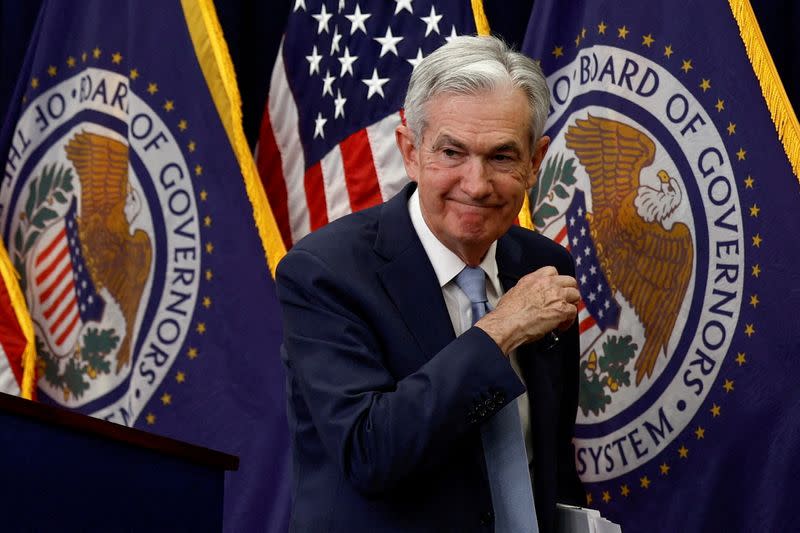Analysis-No turning back: Global central banks vow to stay the course on inflation
By Howard Schneider
WASHINGTON (Reuters) - Central banks in Europe on Thursday followed the Federal Reserve in slowing the pace of interest rate increases but also offered a similar stark message that financial conditions will continue to tighten even as economic performance deteriorates.
Recent months have offered at least initial confidence that the developed world's shared outbreak of inflation, driven by shocks including the coronavirus pandemic and the war in Ukraine, had peaked and begun to ease.
But it hasn't gone away, and policymakers in Frankfurt, London and Washington, responsible for overseeing a large chunk of the world's economy, now face the difficult task of determining just how much further to tighten monetary policy as recession takes hold in the United Kingdom and the euro zone and threatens the United States next year.
It's a set of decisions that will shape the global economy in 2023, influencing exchange rates and terms of trade, and, as some international officials have warned, risking a deeper-than-needed correction if they get it wrong.
"The euro area economy may contract in the current quarter and the next quarter, owing to the energy crisis, high uncertainty, weakening global economic activity and tighter financing conditions," the European Central Bank said in a policy statement on Thursday that marched ahead with a half-percentage-point increase in its key interest rates and argued those rates "still have to rise significantly at a steady pace" even amid the economic slowdown.
The statement pushed the euro higher against the dollar while U.S. equity markets sold off for a second day following what was construed as a hawkish tone from Fed Chair Jerome Powell in his news conference on Wednesday after a two-day policy meeting.The policy moves and the messages from the Fed, ECB and Bank of England continue running along the same track as officials steel themselves for what is among the toughest calls in monetary policy: tightening credit conditions into a recession.
The United Kingdom is "expected to be in recession for a prolonged period," the Bank of England said in a statement on Thursday that raised the target policy rate from 3% to 3.5% and indicated more hikes were likely.
"Further increases ... may be required for a sustainable return of inflation" to the central bank's 2% target, the BoE said, with officials promising to "respond forcefully" if inflation proves faster or more persistent than expected.
'STAY THE COURSE'
All three central banks did slow the pace of their rate hikes. The half-percentage-point increases in borrowing costs delivered this week are a step back from the 75-basis-point rises that policymakers approved as inflation escalated over the year, offering a more careful way to approach an eventual stopping point.
But the Fed, ECB and BoE also took pains to tell the public and financial markets they were making no promises about where that stopping point might be - an effort to ensure expectations remain in check particularly among investors looking for signs of a central bank pause or even a pivot to rate cuts.
That won't happen, central bankers said this week, until it is clear that inflation is on a sustained fall from a current level around 6% in the United States and above 10% in the United Kingdom and euro zone.
"Ongoing increases will be appropriate in order to attain a stance of monetary policy that is sufficiently restrictive to return inflation to 2% over time," the Fed said in a policy statement on Wednesday that lifted its benchmark overnight interest rate to a range between 4.25% and 4.5%, and projected it would rise to at least a level between 5% and 5.25% by the end of next year.
Projections from individual Fed policymakers showed a likely bias even higher, with seven of 19 already seeing the need for an additional quarter or half a percentage point of rate hikes.
"We will stay the course until the job is done," Powell told reporters after the policy meeting, which was the last of this year.
The issue Powell and his colleagues in Frankfurt and London may increasingly face in 2023 is the rising cost that their interest rate hikes extract in terms of slow or negative growth and increased joblessness, a tradeoff that may get harder to justify if inflation falls quickly at first, as expected, but then becomes harder to nudge lower.
The United States is not currently in a recession, but economists expect at least a mild one to develop next year. New projections from Fed officials on Wednesday came close to acknowledging that likelihood, with growth expected to slow to a tepid 0.5% in 2023, and the unemployment rate to rise nearly a full percentage point.
If U.S. officials are aligned right now about where monetary policy is heading in 2023, new projections show a cavernous split by 2024 about the "appropriate" level of the federal funds rate, with one U.S. central bank official seeing it still above 5.5%, and one other as low as 3%.
Between now and then the world may have to weather a global recession, absorb the continued impact of the war in Ukraine, the uncertainty associated with China's new COVID-19 policy, and any unanticipated shocks beyond those of tighter monetary policy itself.
The baseline outlook is for a "relatively shallow global recession" beginning now and lasting through the middle of 2023, Adam Slater, lead economist at Oxford Economics, wrote in a note. But declines in financial and property markets, the very parts of the economy where the impact of monetary policy is most immediately felt, point to a "significant risk of a somewhat deeper recession ... perhaps exacerbated by constrained room for maneuver on the part of policymakers grappling with large fiscal deficits and high inflation."
(Reporting by Howard Schneider; Editing by Dan Burns and Paul Simao)

 Yahoo Finance
Yahoo Finance 

